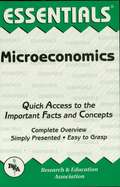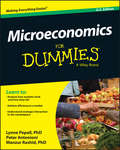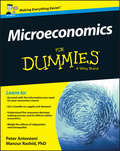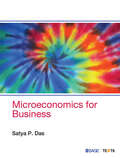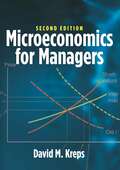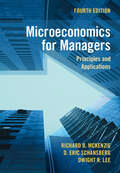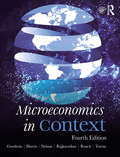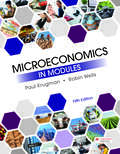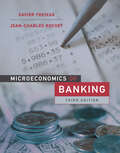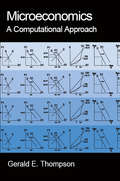- Table View
- List View
Microeconomics Eighth Edition
by Robert S. Pindyck Daniel L. RubinfeldA book that provides a treatment of microeconomic theory that stresses the relevance and application to managerial and public policy decision making.
Microeconomics Essentials
by The Editors of REAREA's Essentials provide quick and easy access to critical information in a variety of different fields, ranging from the most basic to the most advanced. As its name implies, these concise, comprehensive study guides summarize the essentials of the field covered. Essentials are helpful when preparing for exams, doing homework and will remain a lasting reference source for students, teachers, and professionals. Microeconomics includes the fundamentals of supply and demand, consumer theory, production, perfect competition, the monopoly, and factor prices.
Microeconomics For Dummies
by Peter Antonioni Manzur Rashid Lynne PepallYour no-nonsense guide to microeconomics The study of microeconomics isn't for the faint of heart. Fortunately, Microeconomics For Dummies is here to help make this tough topic accessible to the masses. If you're a business or finance major looking to supplement your college-level microeconomics coursework--or a professional who wants to expand your general economics knowledge into the microeconomics area--this friendly and authoritative guide will take your comprehension of the subject from micro to macro in no time! Cutting through confusing jargon and complemented with tons of step-by-step instructions and explanations, it helps you discover how real individuals and businesses use microeconomics to analyze trends from the bottom up in order to make smart decisions. Snagging a job as an economist is fiercely competitive--and highly lucrative. Having microeconomics under your belt as you work toward completing your degree will put you head and shoulders above the competition and set you on the course for career advancement once you land a job. So what are you waiting for? Analyze small-scale market mechanisms Determine the elasticity of products within the market systems Decide upon an efficient way to allocate goods and services Score higher in your microeconomics class Everything you need to make microeconomics your minion is a page away!
Microeconomics For Dummies (UK Edition)
by Peter Antonioni Manzur RashidYour one-stop guide to understanding Microeconomics Microeconomics For Dummies (with content specific to the UK reader) is designed to help you understand the economics of individuals. Using concise explanations and accessible content that tracks directly to an undergraduate course, this book provides a student-focused course supplement with an in-depth examination of each topic. This invaluable companion provides clear information and real-world examples that bring microeconomics to life and introduces you to all the key concepts. From supply and demand to market competition, you'll understand how the economy works on an individual level, and how it affects you every day. Before long, you'll be conversant in consumers, costs, and competition. Microeconomics is all about the behaviour of individual people and individual firms. It sounds pretty straightforward, but it gets complicated early on. You may not be an economist, but if you're a business student at university, the odds are you need to come to grips with microeconomics. That's where Microeconomics For Dummies comes in, walking you through the fundamental concepts and giving you the understanding you need to master the material. Understand supply, demand, and equilibrium Examine the consumer decision making process Delve into elasticity and costs of production Learn why competition is healthy and monopolies are not Even the brightest business students can find economics intimidating, but the material is essential to a solid grasp of how the business world works. The good news is that you've come to the right place.
Microeconomics Made Simple: Basic Microeconomic Principles Explained in 100 Pages
by Austin Frakt Mike PiperMicroeconomics Made Simple: Basic Microeconomic Principles Explained in 100 Pages or Less (Financial Topics in 100 Pages or Less)
Microeconomics and Human Behavior: Toward a New Synthesis of Economics and Psychology
by David A. AlhadeffThis title is part of UC Press's Voices Revived program, which commemorates University of California Press’s mission to seek out and cultivate the brightest minds and give them voice, reach, and impact. Drawing on a backlist dating to 1893, Voices Revived makes high-quality, peer-reviewed scholarship accessible once again using print-on-demand technology. This title was originally published in 1982.
Microeconomics for Business (SAGE Texts)
by Satya P DasThis book breaks away from standard microeconomics textbooks for management students in numerous ways. Some of its relevant and useful features are: · A strong emphasis on concepts, their explanation, understanding and application · Graphical and logical derivations supplemented by economic intuition in easy-to-understand English, while retaining the rigour of algebraic treatment · Numerous real-life examples, largely pertaining to India · Two unique chapters: Demand for Assets and Game Theory and Economic Applications · Questions at the end of each chapter, emphasising the application of concepts This book will be valuable for BBA and B.Com. students and also for those pursuing Managerial Economics at the Masters level.
Microeconomics for MBAs
by Dwight R. Lee Richard B. MckenzieThe textbook that develops the economic way of thinking through problems that MBA students will find relevant to their career goals. Theory and math is kept as simple as possible and illustrated with real-life scenarios. This textbook package includes online video tutorials on key concepts and complex arguments, and topics likely to be assessed in exams. The distinguished author team has developed this textbook over 20 years of teaching microeconomics to MBA students. Chapters are clearly structured to support learning: Part I of each chapter develops key economic principles. Part II draws on those principles to discuss organizational and incentive issues in management and focuses on solving the 'principal-agent' problem to maximize the profitability of the firm - lessons that can be applied to problems MBAs will face in the future. Economics and management are treated equally; this unique textbook presents economics as part of the everyday thinking of business people.
Microeconomics for MBAs
by Dwight R. Lee Richard B. Mckenzie McKenzie, Richard B. and Lee, Dwight R.The textbook that develops the economic way of thinking through problems that MBA students will find relevant to their career goals. Theory and math is kept as simple as possible and illustrated with real-life scenarios. This textbook package includes online video tutorials on key concepts and complex arguments, and topics likely to be assessed in exams. The distinguished author team has developed this textbook over 20 years of teaching microeconomics to MBA students. Chapters are clearly structured to support learning: Part I of each chapter develops key economic principles. Part II draws on those principles to discuss organizational and incentive issues in management and focuses on solving the 'principal-agent' problem to maximize the profitability of the firm - lessons that can be applied to problems MBAs will face in the future. Economics and management are treated equally; this unique textbook presents economics as part of the everyday thinking of business people.
Microeconomics for Managers
by David M. KrepsThis is a thoroughly revised and substantially streamlined new edition of a leading textbook that shows MBA students how understanding economics can help them make smarter and better-informed real-world management decisions. David Kreps, one of the world’s most influential economists, has developed and refined Microeconomics for Managers over decades of teaching at Stanford’s Graduate School of Business. Stressing game theory and strategic thinking and driven by in-depth, integrated case studies, the book shows future managers how economics can provide practical answers to critical business problems.
Microeconomics for Managers: Principles and Applications
by Richard B. McKenzie D. Eric Schansberg Dwight R. LeeThis fully updated fourth edition explores microeconomic concepts, with a distinctive emphasis on 'the economic way of thinking' and its applicability to sharp managerial thinking, productivity, and good decision-making. It stands apart due to its strong focus on practical and applied knowledge from the business context and its unique structure (Part I of each chapter develops key economic principles; Part II draws on those principles to discuss organizational and incentive issues in management, focusing on solving the 'principal-agent' problem to maximize the profitability of the firm). There are plentiful real-life scenarios and provocative examples in each chapter. Accessible to MBA students, other graduate students and undergraduates, it is ideal as a core text for courses in Managerial Economics. Requiring an understanding of only basic algebra, this new edition is more concise with a wealth of online resources, including additional online chapters and an online appendix with more advanced mathematical applications.
Microeconomics for Today
by Irvin B. TuckerThe most reader-friendly economics approach available, MICROECONOMICS FOR TODAY, 10E by national award-winning educator Irvin Tucker presents Macro and Micro economic concepts using a writing style that is both engaging and clear, no matter what your current level of economic understanding. <p><p> A unique presentation and visual learning system, colorful graphs, and Causation Chains clarify and illustrate important economic principles. The book concisely presents and reinforces core concepts, while online resources immediately facilitate assessment of understanding, and will study the latest information on economic growth, income distribution, federal deficits, environmental issues, and other developments in economics today. <p><p> The book's easy-to-follow format demonstrates how to apply principles to your everyday life, while numerous printed and digital study tools help you further master key current economic principles.
Microeconomics for the Critical Mind: Mainstream and Heterodox Analyses (Classroom Companion: Economics)
by Fabio PetriThis textbook explains comprehensively and in rigorous detail not only mainstream microeconomics, but also why many economists are dissatisfied with major aspects of it, and the alternative that they are exploring in response: the Classical-Keynesian-Kaleckian approach. This advanced yet user-friendly book allows readers to grasp the standard theory of consumers, firms, imperfect competition, general equilibrium, uncertainty, games and asymmetric information. Furthermore, it examines the classical approaches to value and income distribution advocated by Adam Smith, David Ricardo and Karl Marx, as well as Post-Keynesian pricing theory, and the microeconomics of variable capacity utilization. Using simple models, it highlights the analytical roots of the important differences between the marginal/neoclassical approach and the classical-Keynesian, critically examining the plausibility and reciprocal consistency of their assumptions.The book also addresses various microeconomic issues not generally included in advanced microeconomics textbooks, including differential land rent, joint-production long-period pricing, capital theory from Walras to the Cambridge debates, the foundations of aggregate production functions, the microeconomics of labor markets, and the long-period theory of wages. Lastly, it presents a unique re-evaluation of welfare economics. Intended for advanced undergraduate and graduate microeconomics courses, this textbook offers a comprehensive introduction to the various approaches and different schools of thought currently competing in the context of economic theory. It can also be used in courses on value and distribution, heterodox economics, and the history of economic analysis. In the present situation, characterized by scientific uncertainty and the co-existence of competing approaches, it will stimulate students to form their own opinion as to which approach appears more promising from a scientific standpoint.
Microeconomics in Context
by Neva Goodwin Jonathan M. Harris Julie A. Nelson Brian Roach Mariano Torras Pratistha Joshi RajkarnikarMicroeconomics in Context lays out the principles of microeconomics in a manner that is thorough, up to date, and relevant to students. Like its counterpart, Macroeconomics in Context, the book is uniquely attuned to economic, social, and environmental realities. The "In Context" books offer an engaging coverage of current research and policy issues from economic inequality and climate change, to taxes and globalization. Key features include: Up-to-date discussions of the impacts of the COVID-19 pandemic on inequality, labor markets, and beyond Analysis of recent trade issues and the implications of Brexit Presentation of policy issues in historical, environmental, institutional, social, political, and ethical contexts—an approach that fosters critical evaluation of the standard microeconomic models Clear explanations of basic concepts and analytical tools, with advanced models presented in optional chapter appendices A powerful graphical presentation of various measures of well-being in the United States and other countries, including income inequality, tax systems, educational attainment, and environmental quality A focus on human well-being from a multidimensional perspective, including traditional economic metrics and factors such as health, equity, and political inclusion A full complement of student and instructor support materials online. The book combines real-world relevance with a thorough grounding in multiple economic paradigms. It is the ideal textbook for modern introductory courses in microeconomics. The book's companion website is available at: www.bu.edu/eci/micro
Microeconomics in Context: Preliminary Edition
by Neva Goodwin Jonathan M. Harris Julie A. Nelson Brian Roach Mariano TorrasMicroeconomics in Context lays out the principles of microeconomics in a manner that is thorough, up to date, and relevant to students. Like its counterpart, Macroeconomics in Context, the book is uniquely attuned to economic realities. The "in Context" books offer affordability, accessible presentation, and engaging coverage of current policy issues from economic inequality and global climate change to taxes.Key features include: --Clear explanation of basic concepts and analytical tools, with advanced models presented in optional chapter appendices;--Presentation of policy issues in historical, institutional, social, political, and ethical context--an approach that fosters critical evaluation of the standard microeconomic models, such as welfare analysis, labor markets, and market competition;--A powerful graphical presentation of various measures of well-being in the United States, from income inequality and educational attainment to home prices; --Broad definition of well-being using both traditional economic metrics and factors such as environmental quality, health, equity, and political inclusion; --New chapters on the economics of the environment, taxes and tax policy, common property and public goods, and welfare analysis; --Expanded coverage of high-interest topics such as behavioral economics, labor markets, and healthcare; --Full complement of instructor and student support materials online, including test banks and grading through Canvas.
Microeconomics in Context: Preliminary Edition
by Neva Goodwin Jonathan M. Harris Julie A. Nelson Brian Roach Mariano Torras Pratistha Joshi RajkarnikarMicroeconomics in Context lays out the principles of microeconomics in a manner that is thorough, up to date, and relevant to students. Like its counterpart, Macroeconomics in Context, the book is uniquely attuned to economic, social, and environmental realities. The "In Context" books offer affordability, accessible presentation, and engaging coverage of current policy issues from economic inequality and global climate change to taxes and globalization. Key features include: Clear explanations of basic concepts and analytical tools, with advanced models presented in optional chapter appendices; Presentation of policy issues in historical, environmental, institutional, social, political, and ethical contexts—an approach that fosters critical evaluation of the standard microeconomic models, such as welfare analysis, labor markets, and market competition; A powerful graphical presentation of various measures of well-being in the United States and other countries, including income inequality, taxes, educational attainment, and environmental quality; Broad definitions of well-being using both traditional economic metrics and factors such as environmental quality, health, equity, and political inclusion; Significantly revised chapters on globalization and trade, economic and social inequality, labor markets, and public goods; Expanded coverage of high-interest topics such as behavioral economics, labor markets, and economic discrimination; Full complement of instructor and student support materials online. This new edition also features more international data and analysis, and further material on the importance of economic power in shaping policy. The latest addition to the "In Context" series combines real-world relevance with a thorough grounding in multiple economic paradigms.
Microeconomics in Modules
by Paul Krugman Robin WellsWhen it comes to explaining fundamental economic principles by drawing on current economic issues and events, there are no authors more effective than Nobel laureate and New York Times columnist Paul Krugman and co-author, Robin Wells. Here, Krugman and Wells’ signature storytelling style and uncanny eye for revealing examples come together in an accessible, modular format to help readers understand how economic concepts play out in our world. Instead of having chapters of traditional length, this version covers the core concepts of economics in a series of brief modules, each focused on one topic and designed to assigned in any order and read comfortably in one sitting. This new edition is more accessible than ever and includes SaplingPlus, a complete, integrated online learning system that supports students and instructors at every stage of learning—pre-class, in-class, and post-class.
Microeconomics in Modules
by Paul Krugman Robin WellsWhen it comes to explaining fundamental economic principles by drawing on current economic issues and events, no one is more effective than Nobel laureate and New York Times columnist Paul Krugman and co-author, Robin Wells. In this modular text, Krugman and Wells’ signature storytelling style helps readers understand economic concepts in the real world. Instead of long, traditional chapters of traditional length, this version presents brief modules, each focused on one topic and easy to read in one sitting.
Microeconomics of Banking
by Jean-Charles Rochet Xavier FreixasThe second edition of an essential text on the microeconomic foundations of banking surveys the latest research in banking theory, with new material that covers recent developments in the field. Over the last thirty years, a new paradigm in banking theory has overturned economists' traditional vision of the banking sector. The asymmetric information model, extremely powerful in many areas of economic theory, has proven useful in banking theory both for explaining the role of banks in the economy and for pointing out structural weaknesses in the banking sector that may justify government intervention. In the past, banking courses in most doctoral programs in economics, business, or finance focused either on management or monetary issues and their macroeconomic consequences; a microeconomic theory of banking did not exist because the Arrow-Debreu general equilibrium model of complete contingent markets (the standard reference at the time) was unable to explain the role of banks in the economy. This text provides students with a guide to the microeconomic theory of banking that has emerged since then, examining the main issues and offering the necessary tools for understanding how they have been modeled. This second edition covers the recent dramatic developments in academic research on the microeconomics of banking, with a focus on four important topics: the theory of two-sided markets and its implications for the payment card industry; “non-price competition” and its effect on the competition-stability tradeoff and the entry of new banks; the transmission of monetary policy and the effect on the functioning of the credit market of capital requirements for banks; and the theoretical foundations of banking regulation, which have been clarified, although recent developments in risk modeling have not yet led to a significant parallel development of economic modeling.
Microeconomics of Banking, third edition
by Jean-Charles Rochet Xavier FreixasThe third edition of a leading text on the microeconomic foundations of banking, comprehensively updated with new coverage of the 2008 Global Financial Crisis, fintech, and the latest research in banking theory.The banking industry has undergone seismic change in the twenty-first century, from the overhaul of regulation in the wake of the 2008 Global Financial Crisis to the digitalization of the economy and the disruption of traditional business models by ascendant tech giants. Now in a comprehensively updated third edition, this essential graduate-level text on the microeconomic foundations of banking provides the rigorous theoretical approach required to understand these new structures and norms, functioning as a user&’s guide to recent academic literature. Microeconomics of Banking offers a comprehensive view of the evolution of banking theory and the rapidly changing realm of financial intermediation, examining the central issues and offering the necessary tools for understanding how they have been modeled. New edition highlights:Up-to-date coverage of the latest research in banking theory as well as the events of the global financial crisis and resultant Basel III regulatory frameworkNew chapters on liquidity and systemic riskNew material throughout on cryptocurrencies, fintech, and other facets of a digitalized economy
Microeconomics using Excel: Integrating Economic Theory, Policy Analysis and Spreadsheet Modelling
by Gerald Schwarz Kurt Jechlitschka Dieter KirschkeUsing Microsoft Excel, the market leading spreadsheet package, this book combines theory with modelling aspects and spreadsheet analysis. Microeconomics Using Excel provides students with the tools with which to better understand microeconomic analysis.It focuses on solving microeconomic problems by integrating economic theory, policy analysis and
Microeconomics, Macroeconomics and Economic Policy
by Philip ArestisMicroeconomics, Macroeconomics and Economic Policy are at the core of research and study in economics. The essays in this volume have been specifically commissioned and brought together to celebrate the work of Malcolm Sawyer, who has made substantial contributions in these areas.
Microeconomics: A Business Perspective
by Rubb SumnerCreated specifically for the economics course as taught in business schools, Economic Principles: A Business Perspective covers the fundamentals of economics in the context of today's globalized business world, with strong examples, integrated technology, and practical pedagogy. Integrated business and policy briefs, in-depth case studies, chapter-ending business applications, thoroughly explained graphs and a battery of simple but useful learning tools support the intersection of theory and practice. It's accompanied by a robust media component, SaplingPlus, which combines Sapling's acclaimed online homework with a complete e-book and all interactive features for the text.
Microeconomics: A Computational Approach
by Gerald E. ThompsonThis concise and comprehensive introduction to economics offers readers at all levels a more realistic approach to understanding the elements of resource and product markets, including the role of business decisions; technological change; product differentiation; uncertainty; and the optimal location of activities. With the book's easy-to-use software package for computations, even non-economists will become strongly motivated and can gain a proficiency in economic analysis as well as in practical and professional decision-making skills. End-of-chapter problems, computer exercises, programming examples, and numerous diagrams further enhance the book's usefulness.
Microeconomics: A Global Text
by Judy WhiteheadMicroeconomics is concerned with the production, consumption and distribution of goods by the micro units of individuals, firms and markets within the economy. It can also be considered a study of scarcity and the choices to be made for the attainment of goals within constraints. These goals are those set by consumers, producers and policy makers in the market. This book provides a brand new approach to the teaching and study of microeconomics – an elementary guide to the fundamental principles of the subject. It gives students from all parts of the world the opportunity to understand and appreciate the value of microeconomic tools and concepts for analyzing market processes in their economic environment, as well as maintaining a perspective on issues of trade and competitiveness, thus drawing attention to the relevance of microeconomic theory beyond the domestic scene to issues of trade and competitiveness on the international arena. The book contains a wealth of international case studies and covers topics such as: - elasticity - Cobb-Douglas Production functions - dynamic stability of market equilibrium - monopolies and monopolistic competition - project analysis The perfect introduction to the building blocks of contemporary microeconomic theory, this book will be of interest to undergraduate students in international economics, industrial economics, managerial economics and agricultural economics. It will also be a useful reference guide for graduates requiring a break down of difficult microeconomic principles.

